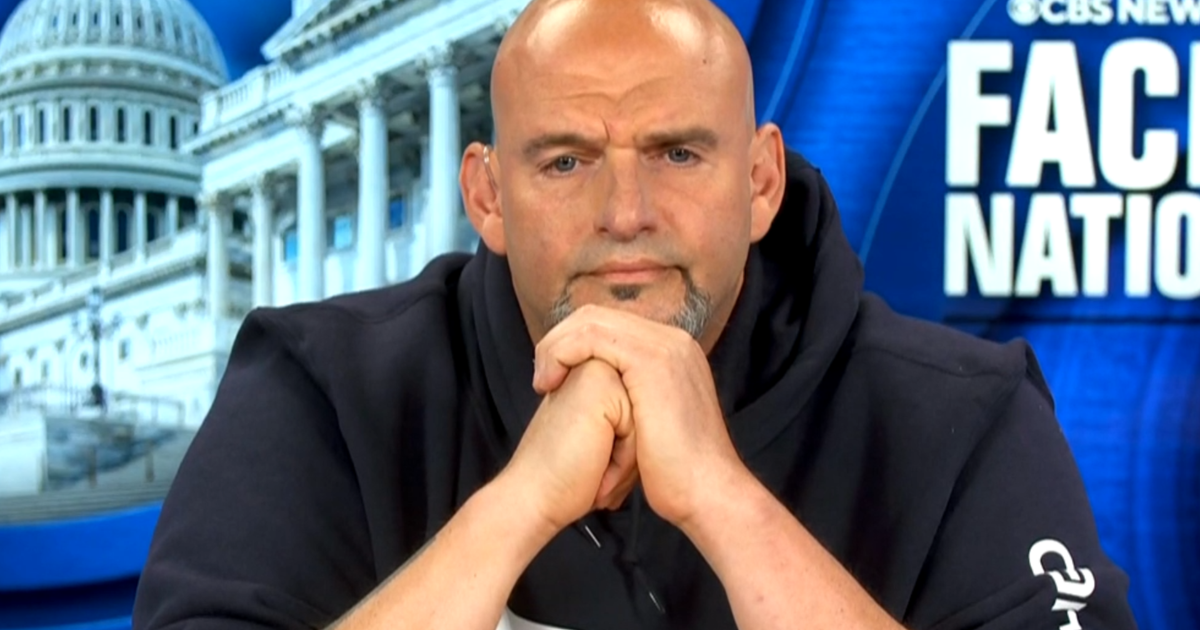Transcript: Scott Gottlieb discusses coronavirus on "Face the Nation," May 17, 2020
The following is a transcript of an interview with former FDA Commissioner Scott Gottlieb by CBS News' Margaret Brennan that aired Sunday, May 10, 2020, on "Face the Nation."
MARGARET BRENNAN: We're back with former FDA commissioner Dr. Scott Gottlieb, who joins us from Westport, Connecticut. Good morning.
DR. SCOTT GOTTLIEB: Good morning.
MARGARET BRENNAN: You heard Secretary Azar say hundreds of millions of people, 300 million doses of a vaccine by January. Is that realistic?
DR. GOTTLIEB: Well, first, we have to remember that the doses probably- we have to cut it in half because many of these vaccines, and Sanofi has already spoken to this, you're going to probably need two doses of the vaccine. So whatever supply we have is probably sufficient to actually dose and inoculate about half the number of people. I think our expectation should be that we're going to have millions of doses of vaccine available in the fall to do large phase three clinical trials, maybe low tens of millions of doses if multiple manufacturers make it through phase one, phase two studies. And we might make them available under an emergency use authorization if we do have outbreaks or an epidemic in the fall for certain high risk groups. Another thing to consider is that these vaccines may not be completely protective. What they may do is prevent you from getting COVID the disease and from getting severe pneumonia but you may still get the infection. So you may still be able to get and transmit the infection, but you just won't get as sick. And that may be how these vaccines ultimately are used. And so what you might do in that situation, if we do have an epidemic, is use the vaccines on people who are really high- at high risk of a bad outcome, like people maybe in a nursing home. But I think our base assumption should be that we'll have millions of vaccines, maybe low tens of millions of vaccines if multiple manufacturers are successful in those early studies.
MARGARET BRENNAN: So 328 million Americans. Eight billion people in the world. They're going to want this overnight. What you're saying is that's not happening by January, period?
DR. GOTTLIEB: Well, remember, it takes- it takes a while to manufacture a vaccine, and then once you manufacture it, you have to do stability testing. So you don't just manufacture a vaccine and roll it off the line and then send it out into the public to be- to have people inoculated with it. You're going to hold it. You do stability testing. So you make sure the vaccine is appropriate for use. In 2009 with H1N1, when we went to make that vaccine, so we had the vaccine construct, it worked well in the laboratory and in small scale studies, when we went to scale up the manufacturing, we found we weren't getting good yield with it. And we actually lost about two months in that process of trying to make that vaccine in time for the fall. So a lot of things- there's a lot of uncertainties as you go from vaccines that you're manufacturing on a smaller scale, in a- in an experimental fashion and early stage studies when you try to scale up and get volume. So a lot of things can go wrong. A lot of things can be delayed. It's very hard to get to the point where you're manufacturing at high, high quantities. I would say that's probably more likely a 2021 event that we're going to have the vaccine available in sufficient quantities to mass inoculate the population. And remember, there might be 200 million people who want this vaccine who are eligible for it. That might take 400 million doses. And so it's probably a 2021 event. I do think we'll have the vaccine available in the fall for use maybe to ring fence an outbreak if you have an outbreak in a large city or to inoculate a certain portion of the population on an experimental basis to protect them because they're at high risk of a bad outcome.
MARGARET BRENNAN: We're learning more about this virus, including the potential risk to children. What would you tell parents who are concerned about these reports out of Italy, the U.K. and now the U.S. that young children are being affected?
DR. GOTTLIEB: Look, the reports are deeply concerning. There appears to be some kind of post-viral syndrome associated with this virus. The WHO and the CDC have now stepped forward and said they've associated with this virus, although it's not definitive, the causal relationship. It appears to be some kind of post viral immune type phenomena. We see this in other kinds of viruses. What we don't know is the denominator. We don't know how many kids have actually had the virus. Is it hundreds of thousands or millions of children that have had the virus and we're seeing, you know, maybe a hundred or 200 of these cases? Or have only thousands of kids had the virus, and we're seeing hundreds of cases? That would be deeply concerning if the incidence was that high. This was first detected by the British April 26. The Italians have reported on a cluster. And then New York City doctors and health officials were the first to report on a cluster here in the United States. They've now reported on more than one hundred of these cases and three tragic deaths. But again, we don't know that denominator of how many kids are getting infected. There was a study in Science Magazine about two weeks ago that said that children are probably a third as likely to get infected with coronavirus as adults. So that means that kids are getting infected, but probably at a much lower rate than adults. But they're still getting infected and if you figure maybe upwards of 20 million people in the U.S. have had the infection at this point, and that's possible, that means a lot of kids might have had it as well.
MARGARET BRENNAN: Well, I know the CDC did put out some guidance on that this week, saying call your pediatrician if your kid has any of the rashes like we just showed you on the screen.
DR. GOTTLIEB: Right.
MARGARET BRENNAN: But on the issue of the CDC, you- you said before on this program, the CDC needs to be sharing more information than they are in terms of what doctors are- are seeing and learning. There need to be more specific guidelines for businesses and schools. You heard a White House adviser say the CDC failed the country on testing this morning. Alex Azar disagreed with that, Health and Human Services secretary. How do you assess what is happening at the CDC right now?
DR. GOTTLIEB: Well, I disagree with that assessment as well about the diagnostic test. Even if the CDC had rolled out that test perfectly, there still wouldn't have been enough testing in place in the nation to do what we call sentinel surveillance to try to detect this virus earlier. What needed to happen was someone needed to pick up the phone and call the CEOs of Lab Corp and Quest and the other big labs, probably sometime in January or at least in early February, and get them spun up--
MARGARET BRENNAN: Who would that person have been?
DR. GOTTLIEB: --because they're the only ones who--
MARGARET BRENNAN: The Health and Human Services secretary? Or the FDA commissioner?
DR. GOTTLIEB: It would have been- it would have been one of those two. It would've been someone within HHS to ask them to spin up tests. And if they had asked the CEOs to do that, I'm- I'm willing to bet that they would have done it and you would have gotten the big labs in the game. That's what needed to happen. As far as CDC is concerned, I mean, I think the part of the agency where I think there could be more information is trying to catalog the collected clinical experience. We've now had more than a million people infected with this in the United States, probably tens of millions of people infected. We've had hundreds of thousands of hospitalizations. 90,000 deaths. We haven't seen a really definitive, systematic accounting of the collected clinical experience with those patients and their outcomes and what interventions were used on them. This is what CDC does: puts out this information is setting a public health emergency so can inform what we're doing. We're learning a lot of this by word of mouth with physicians, even on Twitter, that there that people have coagulopathy- apathy. So their blood's clotting. We're learning that maybe you shouldn't be ventilating patients on respirators as aggressively as we were. We're learning that many patients are getting blood clots to their lungs and that's what may be causing some of the rapid decompensation. Now we're learning about this pediatric syndrome. So we're learning a lot that should be coming from the CDC. I think that's where we can be doing much more, putting out this information. And the guidelines are a separate matter.
MARGARET BRENNAN: OK.
DR. GOTTLIEB: I think the more that CDC puts out very detailed guidelines, the better businesses can restart.
MARGARET BRENNAN: All of us want more facts. Thank you, Dr. Gottlieb. Appreciate it.
DR. GOTTLIEB: Thanks a lot.
MARGARET BRENNAN: We'll get to that in a moment.



